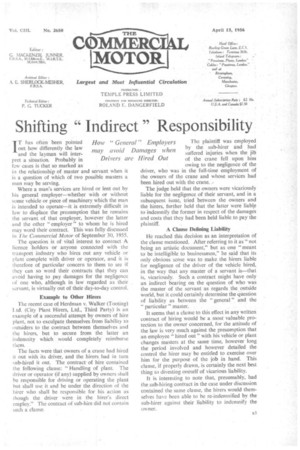Shifting " Indirect " Responsibility
Page 37

If you've noticed an error in this article please click here to report it so we can fix it.
IT has often been pointed out how differently the law and the layman will interpret a situation. Probably in few cases is that so marked as in the relationship of master and servant when it is a question of which of two possible masters a man may be serving.
Where a man's services are hired or lent out by his general employer—whether with or without some vehicle or piece of machinery which the man is intended to operate—it is extremely difficult in law to displace the presumption that he remains the servant of that employer, however the latter and the other " employer " to whom he is hired may word their contract. This was fully discussed in The Commercial Motor of September 30, 1955.
The question is of vital interest to contract A licence holders or anyone connected with the transport industry who hires out any vehicle or plant complete with driver or operator, and it is therefore of particular concern to them to see if they can so word their contracts that they can avoid having to pay damages for the negligence of one who, although in law regarded as their servant, is virtually out of their day-to-day control.
Example to Other Hirers The recent case of Herdman v. Walker (Tooting) I.td. (City Plant Hirers, Ltd., Third Party) is an example of a successful attempt by owners of hire plant, not to exculpate themselves from liability to outsiders to the contract between themselves and the hirers, but to secure from the latter an indemnity which would completely reimburse them.
The facts were that owners of a crane had hired it out with its driver, and the hirers had in turn sub-hired it out. The contract of hire contained the following clause: "Handling of plant. The driver or operator (if any) supplied by owners shall be responsible for driving or operating the plant hut shall use it and be under the direction of the hirer who shall be responsible for his action as though the driver were in the hirer's .direct employ." The contract of sub-hire did not contain such a clause. The plaintiff was employed by the sub-hirer and had suffered injuries when the jib of the crane fell upon' him owing to the negligence of the driver, who was in the full-time employment of the owners of the crane and whose services had been hired out with the crane. , The judge held that the owners were vicariously liable for the negligence of their servant, and in a subsequent issue, tried between the owners and the hirers, further held that the latter were liable to indemnify the former in respect of the damages and costs that they had been held liable to pay the plaintiff, A Clause Defining Liability lie reached this decision as an interpretation of the clause mentioned. After referring to it as "not being an artistic document," but as one "meant to be intelligible to businessmen," he said that its only obvious sense was to make the hirers liable for negligence of the driver of the vehicle hired, in the way that any master of a servant is—that is, vicariously. Such a contract might have only an indirect bearing on the question of who was the master of the servant as regards the outside world, but it could certainly determine the question of liability as between the " general ". and the " particular " master. .
It seems that a clause to this effect in any written contract of hiring would be a most valuable protection to the owner concerned, for the attitude of the law is very much against the presumption that an employee "hired out " with his vehicle or plant changes masters at the same time, however long the period involved and however detailed the control the hirer may be entitled to exercise over him for the purpose of the job in hand. This clause, if properly drawn, is certainly the next best thing to divesting oneself of vicarious liability.
It is interesting to note that, presumably, had the sub-hiring contract in the case under discussion contained the same clause, the hirers would themselves have been able to be re-indemnified by the sub-hirer against their liability to indemnify the owner.




















































































































